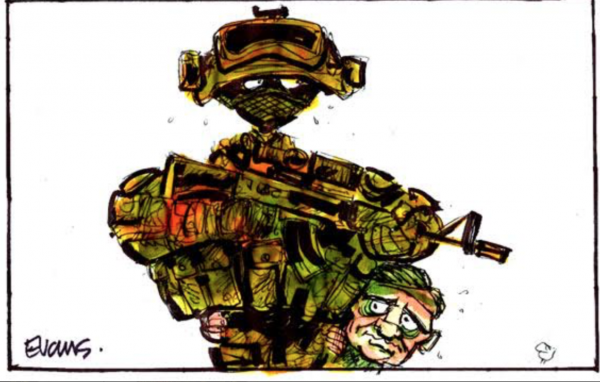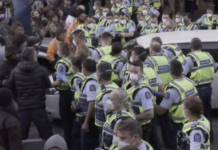
It can’t have been easy for the New Zealand Defence Force (NZDF) and their political leaders to deny the results of a botched military intervention in which 21 civilians were killed or wounded. The task becomes next to impossible in the face of testimonies from survivors and witnesses and the local government documents listing the names of the killed and wounded. When such evidence is fact-checked against the known coordinates and timeline of the operation, only one conclusion seems plausible: the official deniers inhabit an alternative world beyond the reach of inquiry, research, proof, disproof and argumentation. The situation reminds me of a hilarious Monty Python sketch in which hapless game show competitors make fabricated claims of authorship or accomplishment. It goes like this:
Host: Good evening and welcome to ‘Stake Your Claim’. And first this evening we have (John Cleese) with us Mr Norman Bowles from Gravesend who claims he wrote all Shakespeare’sworks… Mr Bowles, I understand that you wrote all those plays normally attributed to Shakespeare.
Mr Bowles: That is correct, I wrote all his plays and my wife and I wrote his sonnets (Michael Palin)
Host: Mr Bowles, these plays are known to have been performed in the early 17th century. How old are you Mr Bowles?
Mr Bowles: Forty three.
Host: Well, how is it possible for you to have written plays performed over 300 years before you were born?
Mr Bowles: Ah well, this is where my claim falls to the ground. There’s no possible way of answering that argument I’m afraid. I was rather hoping you wouldn’t make that particular point. But I can see that you are more than a match for me.
Here, Mr Bowles’ claims cannot survive the merest scrutiny. In the absence of time travel, he could not possibly have written any of Shakespeare’s plays. Satirically speaking, recent statements from the Chief of the New Zealand Defence Force, appear just as untenable. His claim that NZDF troops never operated in the villages of Naik and Khak Khuday Dad contradicts all available testimony and documentary records. The onus of proof is on the NZDF. They have to demonstrate, empirically and legally, that the ‘hit and run’ case compiled by Nicky Hager and Jon Stephenson is false. The NZDF’s associated claim, that the military operation took place elsewhere in a settlement called Tirgiran requires justification. Available geographic evidence suggests that Tirgiran is a river valley rather than a settlement. If the NZDF cannot prove that such a substantial raid occurred (at a particular location outside of Naik and Khak Khuday Dad), then Hager and Stephenson’s case stands. These and other matters must be addressed by an independent commission of inquiry. The public needs to know whether the SAS committed war crimes in their pursuit of enemy combatants.
In this eventuality, Hit and Run represents a basic outline of the prosecution case. The authors argue that operation Burnham was an attempted retaliatory raid against the insurgents responsible for a roadside bomb which had killed a New Zealand solider, Lieutenant Timothy O’Donnell in August 2010. Based on the intelligence gathered, and the kill-capture authorisations of US military commanders, the SAS along with Afghan commandos landed near the villages, supported by US Apache helicopters. Although no insurgents were found, a dozen houses were burnt or blown up. At Naik and Khak Khuday Dad, four civilians including a three year old child were killed by helicopter fire. The extent to which Apache helicopter pilots were directed by the SAS on the ground is yet to be determined. According to local testimony, two other deaths at Khak Khuday Dad are said to have resulted from bullet wounds, perhaps from sniper fire. Hager and Stephenson maintain that SAS soldiers later returned to the villages to destroy partially rebuilt houses. Furthermore, a leading insurgent, allegedly involved in the death of Tim O’Donnell, is said to have been bound and beaten inside an SAS vehicle after capture. These need to be legally tested at a commission of inquiry.
The construction of this book was a painstaking and dangerous enterprise. John Stephenson risked life and limb by returning to the villages and interviewing survivors, and assembling the family trees of the dead and wounded. Empty shell casings from Apache helicopter cannon rounds were collected and photographed. A series of locally sourced stories from the Pajhwok News Agency, pointing to civilian deaths and casualties were filed. And, as mentioned earlier, a locally documented list of the dead and wounded was obtained and photocopied. By triangulating this material with the admissions of anonymous sources throughout the SAS and NZDF, Hager and Stephenson have built a powerful case.
The ramifications of the events described are considerable. Allow me to compile a small list:
- The official cover up and denials concerning the raids within the NZDF suggests a lack of top level accountability.
- Government deference to the NZDF has allowed a military clique to usurp civilian authority over foreign policy.
- The range of military sources available to the authors points to division and dysfunction within the Army, SAS and the NZDF itself.
- The rationale and purpose of New Zealand’s foreign policy, in contradistinction to our ‘five eyes’ obligations is impossible to determine.
Is the New Zealand government and New Zealand Defence Force likely to reflect upon these ramifications? Probably not. I think it is more likely that Mr Bowles did in fact write all of Shakespeare’s plays.






THANKS WAYNE,
Yes we do need to test this case properly outside the Government and NZDF hands as we need to get at the real truth not smoke and mirrors as we clearly see right now.
The government are clearly trying to plaster over the cracks and blame others for their own trigger happy behaviour here.
I give Nicky & John full marks for their dedication to expose this carefully clinical cover-up from us ever knowing what really happened in our god global name as supposedly “top peacemakers and keepers as this was not the way done by the NZDF.
The Amnesty International New Zealand petition regarding this can be found here:
https://www.amnesty.org.nz/did-nz-commit-war-crimes?take-action
As a start, JUST answering the ’16 questions’ might go some way towards proving TK is a ‘man of integrity’ as Andrew Little has suggested, rather than that of a man in a priviledged position ducking for cover and ‘incoming’.
The bullshit and spin that’s now going on is just astounding. It’s far easier to just front up and tell the truth – it might ekshully setcha free (going forward)
Christ! – even Wayne Mapp (just as we’re all willing to vilify the guy because his ideology doesn’t match ours) knows something isn’t quite right. And that’s coming from someone in peacetime who’d argue the guy is an ideologically-driven muppet – he’s in good company though – they rank amongst the most senior in the current Gnatz.
So, if the “wrong village” was named in Hager/Stevenson’s book, where did the shells come from, I wonder? I know, I know! The Taliban concocted the whole thing and left evidence lying around so two intrepid investigative reporters could stumble across them at some future date!
Mr Keating, take note. There’s your alibi.
I have read advice from lawyer on another blog the advice that the NZDF should just shut up and that it is up to the prosecution to prove these allegations. I can only ask what about ” nothing to fear nothing to hide”, isn’t this the new mantra and that all us good citizens accept and that those that do not open our underwater draw for inspection can rightfully be considered kiddy killers or what ever it is that we are accused off.
The conflicted nature of the NZDF is reflected in their deep ties to a foreign power above the interests of New Zealand. These links are reinforced by the GCSB through ‘5 Eyes’ and other secret intelligence and military links. It is why New Zealand troops were in Afghanistan in the first place. It is why we were in Vietnam, it is why we have troops in Iraq now. It is why a kack-handed, over the top, para-military police force with shadowy SAS support, raided Tuhoe. Far from the main theatre of war, our intelligence and military leaders had a need to prove New Zealand’s gung-ho “War On Terror” credentials to their big brother overseas.
All these secret military and intelligence links and attachments do not allow any local democratic oversight, or civilian scrutiny, which should come as no surprise to most…
But while this situation continues, a repetition is almost guaranteed.
We need to wrest back this country’s democratic control of the NZDF from our military leaders who give their primary allegiance to a foreign military and political power.
Thanks, Wayne.
The contradictions emanating from NZDF suggest only one thing; our military is unable to offer a sound, rational explanation to the allegations made by Nicky Hager, Jon Stephenson, and the people of Naik and Khak Khuday Dad.
These can only be investigated by a full Commission of Inquiry.
If National doesn’t do it, the International Court of Justice may well step in.
This is a sad, dark day in our history when a governing party and the armed forces appear to be conspiring to hide the truth from us.
What is it the Right are fond of telling us when ramping up GCSB and SIS surveillance-powers;
That is not the impression we are getting.
The onus of proof SHOULD be on the authority system, after presentation of the Facts. However, In the post FF911 GWOT reversals, onus falls on ‘citizens’ who struggle against systemic state denial of them, where all and any proofs are ‘mitigated’ behind National security firewalls.
NOT to have the war-crime evidence presented or contested under legal rule is the central intention of any good cover-up, which – obviously – this is. There is certainly enough evidence here to call for fierce inquiry. In any Just society where truth was the object, one would have been implemented immediately after ‘Other Peoples Wars’ first established the atrocity.
NZDF/Government reactions so far prove Nicky and Jon have the case.
“NZDF/Government reactions so far prove Nicky and Jon have the case”
Just my thoughts as well, Remo. The ducking-and-diving from English on this issue leads me to the inescapable conclusion that NZDF is hiding something very unpleasant, very murky, and possibly very illegal.
There’s no other way to conclude with their constantly shifting story.
Bill English should be thoroughly ashamed of himself. Calls himself a “Christian”, does he??
What’s in a name?
There are many differences between the Mai Lai Massacre and what New Zealand did at Naik and Khak Khuday Dad.
For one thing, the US military authorities never sank so low as to use confusion over the names of the two villages to prevent a hearing.
One other, is that it did end up in an investigation and a hearing.
Another, is that the US soldiers involved were not given medals for their actions at Mai Lai.
Though the scale and horror may have been greater, none of the US troops were ever given awards, or other official military endorsement for their actions.
And there will never be a public investigation, or hearing, or court case, into what happened at Naik and Khak Khuday Dad.
This is the key difference.
And why, such attacks by our troops can not be ruled out from being ordered, and carried out again.
Other similarities:
https://en.wikipedia.org/wiki/My_Lai_Massacre
Sound familiar?
Revenge raid for the death of a popular soldier killed by a booby trap, (IED).
The burning of buildings.
The shooting to death of two men, who were running away .
These are all allegations made in the book ‘Hit and Run’ against the NZDF by journalists Nicky Hager and Jon Stephenson.
To avoid a repeat ever occurring, these allegations must be investigated in a public hearing of some type.
Another similarity is that the village known as My Lai by the Americans is known as Son My by the Vietnamese.
A big difference being that the US military did not make a big song and dance about the difference in the village names or their exact location to hide from the allegations.
But the biggest difference of all between My Lai (or Son My), apart from scale, is that what happened at My Lai did go to an open investigation and hearing.
Comments are closed.